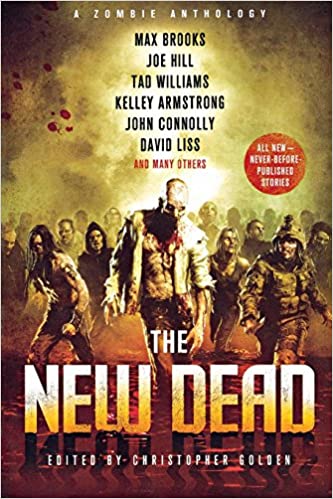 Edited By CHRISTOPHER GOLDEN (St. Martin’s Griffin; 2010)
Edited By CHRISTOPHER GOLDEN (St. Martin’s Griffin; 2010)
I wish I could say this zombie-themed anthology was the landmark it so desperately wants to be. The stories, by talented guys like Max Brooks, Joe Hill, Joe R. Lansdale and many others, are solid for the most part, but I didn’t find the book overall to be anything special. For me the definitive zombie anthology will always be the two volume John Skipp-Craig Spector edited BOOK OF THE DEAD (1989/92), and THE NEW DEAD did nothing to challenge its standing.
The opening story is “Lazarus” by John Connolly, a dour look at the world’s first zombie, brought back to life by Jesus Christ. It’s followed by the more interesting “What Maisie Knew” by David Liss, about people who get off on raping and murdering zombies (or, as they’re termed in this story, reanimates)…and the possibility of one of those rapist-killers turned into the authorities by a talking severed head!
The standout entry, I feel, is “Family Business” by Jonathan Maberry, about a naïve young man learning the business of zombie killing from his older brother. In contrast to all the stylistic gimmickry of so many of these tales, this one achieves its effects through unpretentious storytelling skill.
For an example of the type of stylistic gimmickry I was referring to, see Stephen R. Bisette’s “Copper.” To be sure, Bissette seems to have some good ideas involving zombie servicemen loose in small town America, but they’re buried by all the pretensions (repetitive single sentence paragraphs, etc.).
Of the star contributors, Max Brooks’ “Closure, Limited” is essentially a lost chapter of his epic WORLD WAR Z (and will likely be incomprehensible to anyone who hasn’t read that book). It’s set aboard a steamer in Iceland where undead “subjects” are carefully made over. “In the Dust” by the talented Tim Lebbon centers on a plague much like those of THE CRAZIES or 28 DAYS LATER, but unlike them is quiet and subdued in tone. Brian Keene provides the four-page “The Wind Cries Mary,” an overly scant but effective zombie romance, while Kelley Armstrong’s “Life Sentence” takes a hackneyed concept—a rich man with inoperable cancer looking for ways to prolong is life–and gives it a reasonably compelling treatment.
Rick Hautala’s “Ghost Trap” is effective largely because of its containment—unlike so many of the other stories, it’s about just one zombie, a creepy man chained up in the ocean. Joe R. Lansdale’s “Shooting Pool” is likewise noteworthy for its tightness. The setting is a pool hall wracked by a killing—or, more accurately, a re-killing.
Joe Hill contributes “Twittering from the Circus of the Dead,” the book’s most overtly experimental piece. It’s composed entirely of a succession of tweets from the twitter account of TYME2WASTE, a girl who accompanies her family to a zombie circus. Hill is largely successful at conveying intrigue and suspense through his audacious formatting, although I’m unsure the story would have worked all that differently without the stylistic overlay.
THE NEW DEAD also contains stories involving voodoo (Holly Newstein’s “Delice”), Tibetan mysticism (Tad Williams’ “The Storm Door”), military experimentation (David Wellington’s “Weaponized”) and sheer nastiness (James A. Moore’s “Kids and Their Toys”). So the book is eclectic, at least, and should satisfy undiscerning zombie fans. But it’s far from the ground-breaker it thinks it is.
